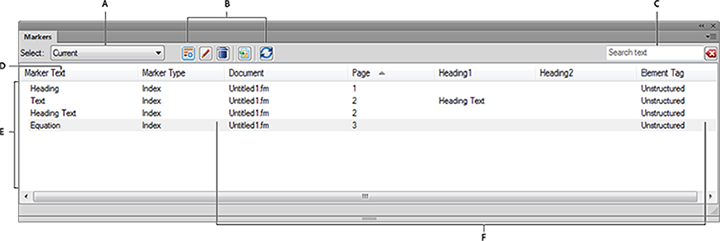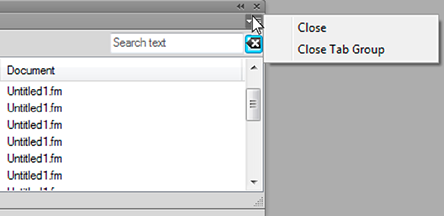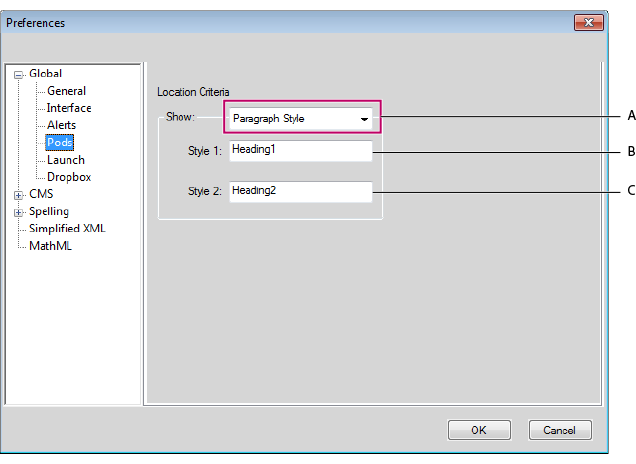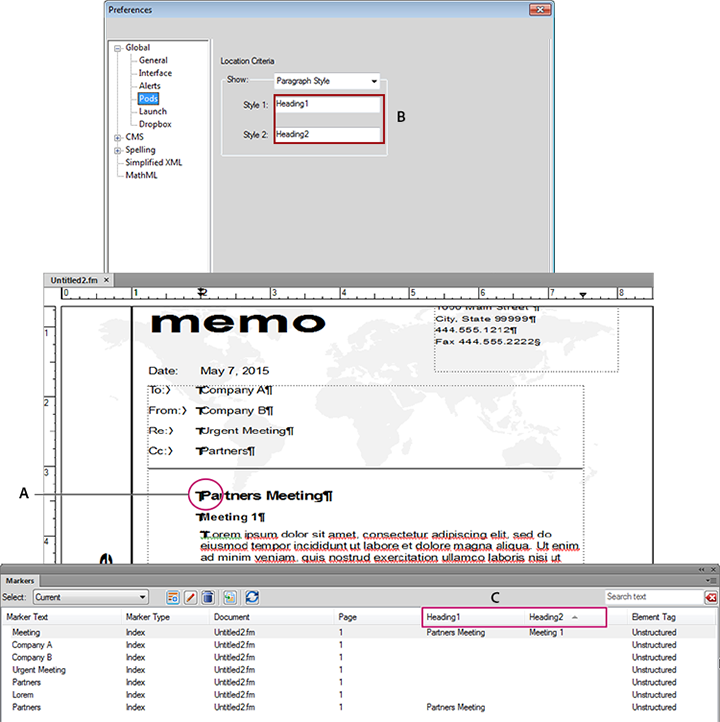Pods
Pods are floating panels with an interface designed to simplify your work. FrameMaker offers the following key pods:
•Conditional Tags pod
•Cross-References pod
•Currently Opened Files pod
•Markers pod
•Fonts pod
•Insets pod
•Variables pod
•References pods
•Currently Opened Files
•Review Comments
Pod interface

A. Select document B. Pod-specific toolbar buttons C. Search pod entries - as you type, FrameMaker searches through all the columns for matches and keeps displaying them D. Arrow on column headers indicates sort order E. Pod list area F. Details of each instance include location. You can customize the location using the Pods Location Criteria dialog box.
Close pods and tab groups
Pods have a button on the right side of the title bar that you can click to close a pod or a tab group (group of pods).

•Close: Closes just the pod in focus (the Markers pod, in this case)
•Close Tab Group: Closes all the pods in the tab group
Also, by double-clicking in the title of a pod, you can minimize or maximize that pod as well as the whole tab group it is a part of.
Pod list area
The Select pop-up displays a list of all open documents, including books and DITA maps. If you select All Open Docs, the pod list area displays all the variables from all the open documents. If you select a specific open document, the pod list area displays variables from the selected document even when you switch to other open documents. The pod list area continues to display the list of instances from the selected document.
If you select the Current option, the pod list area displays the list of instances from the selected document. The list area refreshes when you switch between open documents. However, when you switch between pods, you may need to click the Refresh button.
If you select an open document
•Single-click an instance in the pod to display the corresponding instance in the document. For example, if you select an image instance from the Insets pod, the corresponding image is also selected in the document view.
•Double-click an instance to do the following for each pod:
Conditional Tags pod
Displays the Add/Edit Condition Tag pod for the selected condition.
Cross-references pod
Displays the Cross-Reference pod for editing the selected cross-reference.
Markers pod
Displays the Markers pod so that you can edit the selected marker definition.
Fonts pod
Displays the Replace Font pod for selecting a replacement font.
Insets pod
Displays the Object Properties pod for the selected inset.
Variables pod
Adds the selected variable at the insertion point in the current document.
Reference pod
Displays the results of the search for locations where a particular element is referenced. This pod is only relevant for DITA documents.
Currently Opened Files
Lets you manage and navigate through large number of open files.
•Click a column name to sort the data in the list area in ascending or descending order.
Review Comments
Displays and lets you manage the review comments received from reviewers
Setting pod location criteria
The pod location criteria determine what should be displayed in the pod list area for an instance by way of identifying its location in the document.
For example, you can define two Paragraph tags that should be displayed as the location identifier for a marker. FrameMaker searches backwards for the first match of the first Paragraph tag that you have specified and displays it in the pod. Suppose you specify the first Paragraph tag as Topic_Title in the Location Criteria dialog box. FrameMaker locates a marker and traverses backwards to display the first topic title in which the marker occurs. If you specify the second Paragraph tag as Article_Name, FrameMaker displays the exact article name to which the topic belongs.
Pod location criteria

A. In structured interface, you can specify either the paragraph styles or the element names. In unstructured FrameMaker, you can only specify paragraph styles. B. Specify the first paragraph style. C. Specify the second paragraph style.
1)Choose Edit > Preferences.
2)Select Pods.
3)Select Element Name if you want the pod to display the element names in which the instance is located.
4)Specify valid element names and click OK.
For example, select Paragraph Style and specify head 2 and head 3 in the Style 1 and Style 2 boxes. In the Markers pod, for each instance of a marker, the first head 2 and head 3 it occurs under is displayed in the pod.
The Markers pod displays the setting for marker location

A. Marker is selected in the document view B. Paragraph styles that you specify in Pod Location Criteria C. Markers pod displays the first head3 title and head2 title in which the marker occurs.